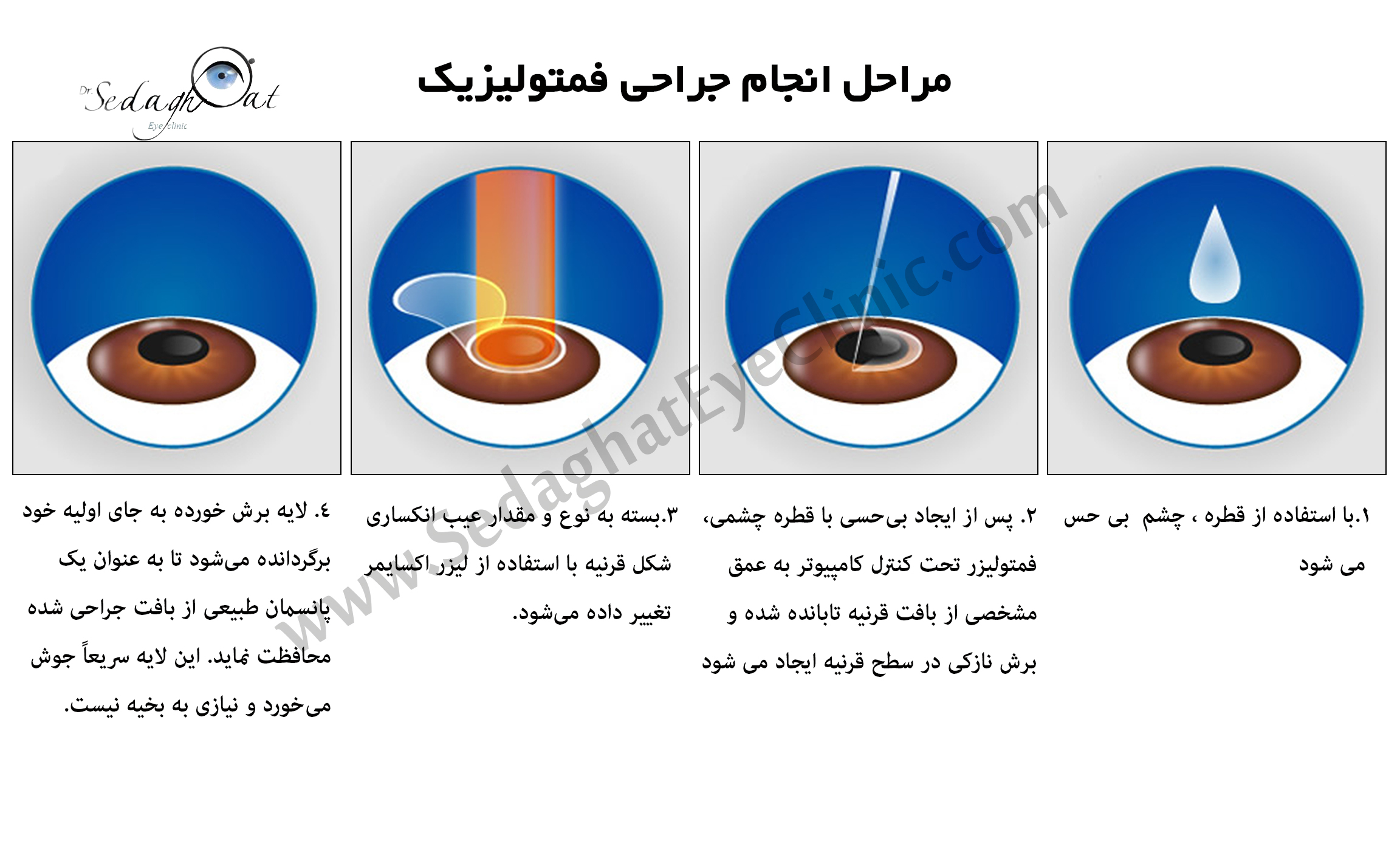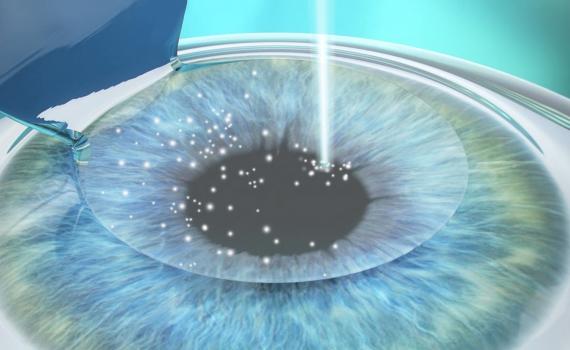One of the most common, precise and safest methods of refractive error surgery is Femto Lasik.
Femto Lasik is considered one of the most common, precise and safest methods of refractive error surgery. It is a two-stage surgery conducted on a person’s cornea. It is one of the newest methods for correcting myopia, hyperopia and astigmatism. Femtosecond laser has diverse applications in ophthalmology. Currently, its most common use is corneal incision during Femto Lasik operation, which can be considered as the superior form of Lasik. Femtosecond laser is a huge development in the technology of cutting materials. Each infrared laser pulse of femtosecond is only a few femtoseconds (10-15 seconds) and therefore any chance of harming the peripheral regions is prevented.
Femtosecond laser devices are equipped with software that can adjust the number, size, amount of energy and frequency of the pulses radiated. Using this software, the exact location of the pulses can be determined in terms of desired depth and breadth. Therefore, when using a femtosecond laser in cornea incision, laser energy concentrates precisely at a specific point in the cornea surface or depth. Each pulse creates a microscopic bubble separating the cornea tissue around itself. Having placed thousands of bubbles together, a very delicate cut can be created in the cornea tissue.

Femto Lasik Surgery technique
Femto Lasik is quite similar to Lasik in terms of surgery procedures, with the difference that in Lasik cornea incision is conducted mechanically using a blade and a microkeratome device. However, in Femto method, it is done using a laser with a more acceptable thickness and extraordinary high precision. At the moment, Femto Lasik is one of the most popular refractive error correction in Europe and the United States. Femto Lasik is done in four steps as follows:
- Using a drop, the eye becomes numb.
- After applying anesthesia, the femto laser is radiated under the control of computer into a certain depth of corneal tissue and a thin incision is made at the cornea surface (approximately 90-110 microns).
- Depending on the type and amount of refractive error, the corneal shape is altered using an excimer.
- As a natural dressing, the layer cut is replaced to protect the tissue undergoing surgery. This layer quickly bonds and does not need any stitches.

Drawbacks of Femto Lasik
- Lasik operation requires a skilled surgeon. Sufficient experience is needed to achieve the appropriate results due to the complexity of the operation.
- Expensive price of Femto Lasik equipment: The high cost of Femto device and the high cost to conduct any operation, and also due to the rapid technological changes, the urgent need for modernization of equipment is needed; the cost of this operation is higher than the PRK.
Benefits of Femto Lasik
- Rapid recovery: Most patients can return to daily activities after one or two days. There is often no pain and after 24 hours, an acceptable vision is developed.
- Repeatability: In the case of lower correction with Lasik operation, it can be repeated by lifting the thin layer that was created during the first operation and repeat the operation. The recovery is fast like the first one. It should be noted that reoperation is usually done with caution and obsession and reoperation has no further costs for the patient.
- Lack of opacity: Contrary to PRK, which has high corneal opacity at high numbers, Lasik does not cause any opacity.
- No need for long-term use of eye drops: Unlike PRK, Lasik operation (which requires up to three months of using different drops), needs no wound control recovery using steroid drops. Lasik patients usually do not need to use these drops for more than a week (only artificial tears for up to 1 month).
Femto Lasik results
Almost everyone undergoing surgery wants to know how is the chance to obtain satisfactory results. For low and moderate myopia (up to 7 diopters), approximately 95% of the patients gain a 5.10-6.10 vision or more without glasses, and 85% gain 8.10-9.10 chance of vision without glasses or better. This means that people’s dependence on the glasses is greatly reduced, however, they may require a low-number glasses to carry out more precise eye work, namely, driving, especially at night. For high myopia (above 7 diopter), approximately 85% vision without glasses as 5.10-6.10 or better, and 70% vision without glasses 8.10-9.10 or better.

Femto Lasik Complications
Complications may also occur in Lasik as with any surgical procedure. Possible complications of Lasik include lower correction, over correction and reduction of the best vision. The lower correction occurs when insufficient tissue is removed to correct the vision, and over correction occurs when more tissue is removed. Lower correction can be corrected in re-operation, but over-correction is more difficult.
During removing a thin layer of femtosecond, problems may occur, including the inability to create a layer with proper size, thickness, or shape, and there is the possibility of post-operation and layer infections. Except for infection, other complications of the layer are usually treated without any problem for the patient’s vision. The probability of infection is 1 in 5000, which is much less than that in contact lenses, and despite the fact that the eye is exposed to infection during using contact lens, its probability of occurrence is limited to the first 1-4 weeks after the operation. After the Lasik operation, refractive errors are corrected and good vision is obtained, though some patients experience more or less one or more of the following complications:
- Viewing a halo or shadow along the image and slight aberration in the first few months is common. However, these complications are rarely troublesome for normal activities. Most of these problems gradually disappear in the first 1-3 months after the operation.
- Myopia at night: In this operation, only the form of central cornea is changed and at night when the pupil is widened at night, the light penetrates from the cornea surrounding, which has not changed, and causes myopia. Even if there is a good vision during the day, glasses might be needed at night.
- Dry eye: During repair, and after Lasik operation, the patient may feel dry eye and require temporary artificial tear drops.
- Discomfort and pain: Lasik pain is often limited to 6-24 hours after surgery and is easily resolved by analgesics. During this period, the eye becomes more sensitive to sunlight. In the first 4 to 6 weeks after the operation, the quality of vision, especially close vision declines, which will gradually and automatically improved. Close vision problems are more common in people with presbyopia and undergo surgery, and these people will need glasses after surgery.

